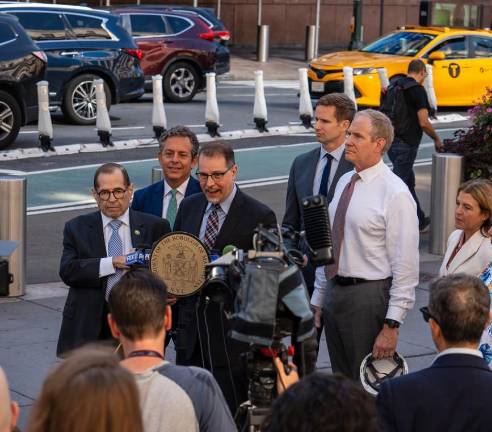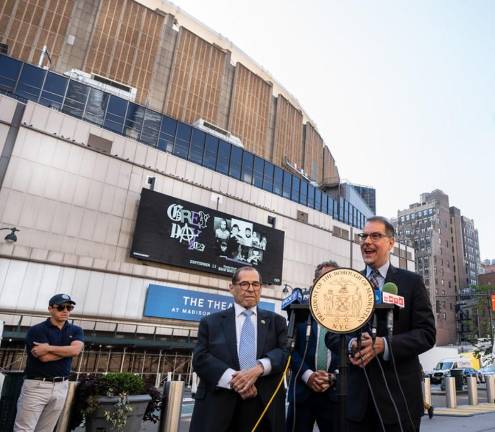Joint Press Conference By Politicos Turns into Debate over Penn Station Plans
Congressman Gerald Nadler, Borough President Mark Levine, and City Council Member Erik Bottcher had heralded their Sept. 12 press conference as the official unveiling of a jointly endorsed new plan for Penn Station and Madison Square. But that’s not how it turned out. MTA Chairman Janno Lieber was also a surprise guest, but his presence was not meant as an endorsement of any new plan.
You would expect a decision as big as rebuilding Penn Station to drive a big debate. What you wouldn’t expect is for government officials to conduct that debate with each other at a joint news conference on Eighth Avenue.
But that is more or less what happened in the latest baffling turn in the long saga of what to do with the busiest, and arguably the worst, rail station in North America.
The odd encounter began when key Manhattan officials, lead by Borough President Mark Levine, Representative Gerald Nadler and Council Member Erik Bottcher, called a news conference to demand a new bidding process to consider the demolition of the Theatre at Madison Square Garden to make make way for a grand Eighth Avenue entrance and train hall.
They were apparently motivated to hold this news conference by frustration with Governor Kathy Hochul, who promised to conduct an open competition for renovation plans but does not seem to have done anything since to get the MTA to expand its thinking to include demolishing the theatre, which the MTA says would be a waste of taxpayer money.
“Think Boldly,” Representative Nadler urged the MTA. “While most Penn Station passengers come from east of Eighth Avenue, Seventh Avenue really, we are also insisting today that we must have a grand entrance on Eighth Avenue.”
They held the news conference on the sidewalk at Eighth Avenue and 32d second street so cameras would show as backdrop the grim façade of the theatre, which one architect described as hanging like a carbuncle off Madison Square Garden.
“What were they thinking leaving us with this blank wall,” asked Levine, who answered his own question by suggesting that when Madison Square Garden and its appended theatre, originally known as the Felt Forum and then the HULU theatre, were built in the 1960’s, the far West Side of Manhattan was far less developed than it is now and drew little focus. “The West Side can no longer be an afterthought,” said Levine.
The elected officials did not have to worry that the MTA, which is overseeing the reconstruction plans, would get their message. The chair, Janno Lieber, was standing next to them. He showed up unannounced, but not to embrace the plan to buy and demolish the theatre.
“The design for the new Penn Station is underway,” Lieber said, referring to the design team the MTA has hired after an earlier bidding process to proceed with a master plan it developed with Amtrak and New Jersey Transit.
That plan emphasizes construction of a train hall on the other side of The Garden, closer to seventh avenue, an area now occupied by a taxiway that has not been used since 9/11. The plan would also improve the current Eight Avenue entrances at the corners of 31st and 33rd streets.
Lieber’s goal seemed to be to slow the push for buying and demolishing the theatre, which the elected officials said should be on the table as part of a new request for proposals that they urged Governor Hochul to issue.
“We want an RFP, a public RFP, that solicits all the best ideas for the train station,” said council member Bottcher. “We want the Hulu theatre taken out to create a grand train station. We’ve got less than five years to do it.”
Bottcher was the key figure in the City Council’s decision to grant Madison Square Garden its needed operating permit for only five years, far shorter than the Garden wanted. The full City Council actually voted on Sept. 14 to officially limit the new permit to only five years, which follows the ten year special permit issued in 2023 and the original 50 year permit issued when MSG was being built in the 1960s.
A press release from Levine’s office said “both Levine and Nadler” called for “a competitive RFP process that will ask that all applicants not only improve the functionality of the station but also transform the surrounding community through a world class ‘grand entrance’” facing west.
But Lieber at the news conference seemed to answer that a new bidding process wasn’t necessary at the moment because the MTA itself would hear all proposals.
“Sometimes things don’t always get through, but the design is underway,” he explained at the news conference. “And now, next month, we’re going to start a process. We’re engaging with elected officials and the community to make sure that the design is done transparently and in partnership with everyone. There are going to be a lot of different versions and a lot of different options, but it’s all going to be done openly and in partnership. We have to make everybody come together.”
The demolition of the theatre has been popularized by an Italian infrastructure company, ASTM, which says it has negotiated an understanding with the owner, Madison Square Garden, on a price, $450 million, to buy the theatre and other property needed for a renovation.
The MTA, on the other hand, says The Garden should cede the necessary property because its location directly on top of the train station is a boon while at the same time creating many challenges to operating the station safely and comfortably for the 600,000 daily users.
ASTM says it will raise the money from private investors and then recoup its investment by managing the renovated station at a fee of $250 million a year.The MTA scoffs at ASTM as an “Italian private equity” firm, although it is also working very closely with its American construction subsidiary on other projects.
The elected officials all tiptoed carefully around the challenge of endorsing the ASTM idea for a grand Eighth Avenue train hall without embracing ASTM itself.
“Our vision, our united vision is to have a grand entrance on Eighth Avenue and have as much light and air as possible in Penn Station,” said Representative Nadler. While Levine and Bottcher were explicit in calling for the demolition of the theatre, Nadler was more circumspect.
“How we accomplish that, whether we knock down the Hulu Theater according to the ASTM plan or not, or some other means, it has to be studied. We’re all agreed that there are options and we have to look at those options. But we’re all agreed on the goals.”
The Garden, for its part, said the selection of a plan was up to others but it would work with everyone.
ASTM has asked Governor Hochul to issue a request for proposals to select what they call a Master Builder to do what ASTM is proposing, conceive and execute the rebuilding of Penn Station and then run it.
Nadler suggested the RFP he and the other officials were calling for was different.
“Before we get a master builder, we have to agree on what we’re doing and that’s what we’re talking about first,” Nadler said. “And the ASTM plan is one plan. It may be the best. There are others who may not be the best. Until we decide after a community input process and the study that we’re talking about doing, what the best plan is, you can’t get a master builder or any builder.”
One advocate for a new Penn station suggested there are additional reasons to reopen the bidding for a Penn Station design. Samuel Turvey, the Chair of ReThinkNYC, said the MTA was wrong to grant that contract to two firms, FX collaborative and WSP, who had already taken a position on a separate but very related issue: whether it is possible to reorganize the operations of the Long Island Railroad and New Jersey Transit to run more trains through without expanding the station.
Turvey said there was a “conflict created by awarding the contract to two firms who had only recently authored a highly discredited through-running opposition research report.”
“Before we get a master builder, we have to agree on what we’re doing and that’s what we’re talking about first.” Rep. Gerald Nadler.

